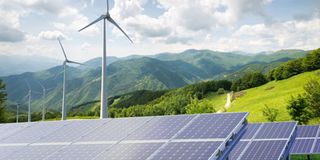Is Tanzania ready to face a looming energy crisis?

What you need to know:
- How Tanzania meets the energy needs of its fast growing and increasingly urban population will determine the nation’s socioeconomic future.
Dar es Salaam this week hosts the fourth Tanzania Energy Conference on August 3 and 4.
In what is touted as the largest conference of its kind, bringing together about 1,000 delegates from 25 countries, the conference provides a marvellous opportunity to review some of Tanzania’s ever-enduring energy issues.
How Tanzania meets the energy needs of its fast growing and increasingly urban population will determine the nation’s socioeconomic future.
It’s worth noting the magnitude of the challenge. In the next 30 years, Tanzania’s population will more than double to around 130 million. During that time, the urban population will quadruple from 15 million to 60 million, with Dar es Salaam storming into the world’s top 20 cities by population before 2050. That earth-shaking demographic transformation will drive growth in the economy and infrastructure and, concomitantly, energy demand.
But Tanzania has been bizarrely slow to awaken to this not-so-new reality. In ten years, for example, while the population has increased by 32 percent and demand by 400 percent – from 1,000MW to over 5,000MW – total installed capacity has barely increased, inching forward from 1,521MW to 1,700MW at a snail’s pace of roughly one percent annually!
Whichever way this story is told, it paints a picture of dereliction of duty of the highest order, and this has come at a substantial cost to Tanzania’s development.
Consider the development of industrial parks.
Industrial parks have become one of the most visible features of developing nations that have dramatically transformed their economies. These nations, by definition, have serious limitations in their infrastructure, policy and business environments. However, by using industrial parks, it is possible to concentrate services and provide one-stop-shop solutions that can significantly improve investors’ experiences.
With around 300 industrial parks, Vietnam is one nation that has used this strategy with outstanding results.
By 1990, Vietnam was slowly emerging from its disastrous experiment with socialism. The economic restoration programme, doi moi, as they call it in Vietnamese, was taking shape, and major investments were being made from Singapore, South Korea, Taiwan, and Japan. Per capita income leapt from $150 to $3,600 in 30 years.
One of the areas that the Vietnamese have taken very seriously is the provision of cheap and reliable energy. In 30 years, energy production increased 25-fold from 8.7TWh to 216TWh in 2021. Today, the price of electricity in Vietnam is significantly lower than even in China.
Like Vietnam, by 1990, Tanzania was also emerging from its equally disastrous experiment with socialism, with per capita income slightly higher than Vietnam’s. However, unlike Vietnam, in 30 years, per capita income has increased to only $1,135, with energy production increasing from 4.4TWh to a paltry 7.1TWh. Similarly, the price of electricity, even though it is not cost-reflective, is one and a half times that of Vietnam.
In the early 2010s when Aliko Dangote proposed opening Tanzania’s biggest cement factory in Mtwara it was cause for celebration for all well-wishers in the region, but years passed and the Dangote Cement’s hullaballoo waned. It was only later that it became apparent that Dangote was involved in an energy spat with the government. Losing $2 million to $3 million per month, Dangote was insisting on having a private arrangement to meet the factory’s demand of 75MW of electricity and ensure reliability. Almost $100 million was spent to solve that problem.
Many investors have faced that kind of challenge in Tanzania. Thanks to non-availability of power, multiple industrial projects in Bagamoyo, Kibaha, Mlandizi, and Mkuranga have yet to be launched. In Tanga, a once-great industrial centre in Tanzania, one can hardly add another factory without seriously upsetting the balance of power – literally.
The difference between Tanzania and Vietnam is that the Vietnamese are known not only for preaching the importance of investors, but also for acting accordingly in creating an appropriate environment to attract them. Factors such as labour costs, utility costs, policy and logistics are carefully choreographed to make Vietnam favourable for FDIs. Today, with 21,000 projects pulling in $300 billion, the Vietnamese are reaping the dividends.
Similarly, with 76,000MW of installed power capacity, Vietnam boasts 300 industrial parks, while Tanzania has only a dozen or so industrial parks that are barely functional.
Come August 3 and 4, the Minister of Energy, Honourable January Makamba, who will grace the Energy Conference, will wax lyrical about Tanzania’s great potential in the energy sector. The charismatic minister will also most probably reiterate how Tanzania is expected to export energy to its neighbours. Indeed, Tanzania is well endowed in that regard and neighbours have been waiting for it to come out of its slumber for decades. But, alas, Tanzanians have only become specialists in rhetoric, and the only thing they have managed to export is hope.
With per capita energy consumption of 103KWh, Tanzania ranks in the bottom ten nations in the world, far below even the lowly sub-Saharan Africa’s standards. No nation that is serious about achieving socioeconomic transformation wants to be in that position. Even with a number of energy projects going on right now, it is still doubtful whether it has turned the corner yet.
It is hoped that one of the conference takeaways will be ‘Tanzania needs to urgently change its outlook vis-à-vis generation and delivery of cheap, sufficient, and reliable energy’.





